High Performance Alloys for Seawater Service
With its considerable industrial benefit as an effluent coolant, seawater remains a corrosive environment to many structural materials. Problems related to localized corrosion, erosion/wear, and biofouling represent limitations to the use of many metallic materials. Cumbersome cathodic protection techniques, unanticipated maintenance costs, along with reliability of equipment, safety to personnel, and environmental concerns are leading to a wider use of higher performance nickel-based alloys in seawater services.

Over the years, the nickel-chromium-molybdenum/tungsten alloys have proven to be among the most reliable and cost-effective materials for aggressive seawater applications. Of these, INCONEL® 625 is considered acceptable and the HASTELLOY® “C-type” alloys (C, C-4, C-276, C-22®) are considered optimum.
Nominal Composition Weight %
| Alloy | Nickel | Chromium | Molybdenum | Tungsten | Others |
| C | Balance | 16 | 16 | 4 | - |
| 625 | Balance | 21.5 | 9 | - | 3.6 Niobium + Tantalum |
| C-276 | Balance | 16 | 16 | 4 | 0.005 Carbon Typical |
| C-4 | Balance | 16 | 16 | 0 | 0.005 Carbon Typical |
| C-22® | Balance | 22 | 13 | 3 | 0.005 Carbon Typical |

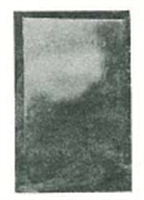
HASTELLOY® alloy shows unsurpassed resistance to corrosion in seawater atmosphere. Exposed at Kure Beach, N. C., since 1942, HASTELLOY® C sample continues to keep its original surface finish while the rest of the test allots have disintegrated long ago.

Localized Corrosion
The high nickel alloys offer excellent resistance to localized corrosive attack (pitting, crevice corrosion), when compared to stainless steels.
| Critical Pitting Temperature (At and Above Which Pitting Occurred) 24 h Exposure 4% NaCl + 0.1% Fe2 (SO4)3 + 0.01 M HCl | ||
| Alloy | °F | °C |
| C-22® | >302 | >150 |
| C-276 | 302 | 150 |
| 625 | 194 | 90 |
| AL-6XN® | 158 | 70 |
| 254SMO® | 140 | 60 |
| FERRALIUM® | 122 | 50 |
| 317LM | 95 | 35 |
| 316L | 68 | 20 |


| Critical Crevice Corrosion Temperature (At and Above Which Corrosion is Observed) 24 h Exposure in 6% FeCl3 Using Different Test Methods | |||
| Alloy | ASTM G-48B | MTL* | Mod MTI* |
| C-22® | 70°C | 70°C | 52.5°C |
| C-276 | 65°C | 55°C | 45°C |
| 625 | 35°C | 35°C | 30°C |
| AL-6XN® | 40°C | - | - |
| 254SMO® | 40°C | - | - |
| FERRALIUM® | 20°C | - | - |
| 317LM | 5°C | 2.5°C | 2.5°C |
| 316L | 0°C | - | - |
*MTI: Material Technology Institute
Reference: E.L. Hibner (Inco) Materials Performance, page 3, March 1987
Seawater Corrosion
The excellent resistance of the high nickel super alloys to localized corrosion attack is maintained in seawater environments. When compared to stainless steels, these alloys offer better resistance to various seawater testing conditions.
High Performance Alloys for Seawater Service Tech Brief 4
| Crevice Samples Tested for 180 Days (Atlantic Coast, 1989) | ||||
| Alloy | Natural Sweater | Seawater Plus 1 ppm Cl2 | ||
| - | % of Creviced Sides Attacked | Maximum Depth of Attack (mils) | % of Creviced Sides Attacked | Maximum Depth of Attack (mils) |
| 316L | 100 | 37 | 100 | 18 |
| 625 | 50 | 0.8 | 100 | 0.8 |
| C-276 | 0 | 0 | 12 | 0.4 |
| C-22® | 0 | 0 | 0 | 0 |
| Crevice Samples Tested for 180 Days (Atlantic Coast, 1989) | |
| - | Maximum Depth of Attack (mils) |
| - | 625 |
| Trickling Seawater | 12 |
| Trickling Seawater+ 90 ppm Cl2 | 25 |
| Circulating* Seawater | 0.8 |
| Circulating Seawater + 90 ppm Cl2 | 61 |
*Circulating velocity = 9.8 ft/sec.


Weld Surfacing Overlay
One practical, engineering approach to provide corrosion protection is the use of high nickel alloy weld overlays. The useful life of a degraded component can be extended and the initial capital cost of a structural component can be lowered by weld overlaying the low alloy substrates with high nickel alloys.
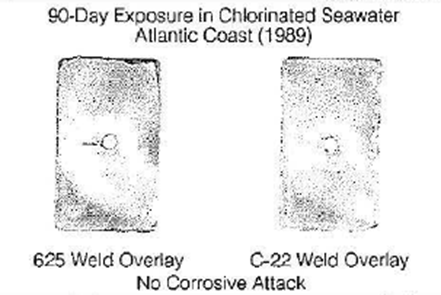
It is of interest to note that the sought after corrosion resistance of “wrought” alloy 625 in the weld overlays on carbon steels can be better achieved by using the more corrosion resistant HASTELLOY® C-22® alloy. The better resistance of C-22® alloy, is illustrated in the simultaneous exposure of both alloys (via the one-sided test) in ASTM G-28B environment (23% H2S04 + 1.2% HCI + 1% FeCI3 + 1% CuCI2).
Test results show that one single layer of C-22® weld overlay is more resistant to localized corrosive attack than double-layer deposit of low iron alloy 625, as well as better resistant than undiluted, wrought alloy 625.

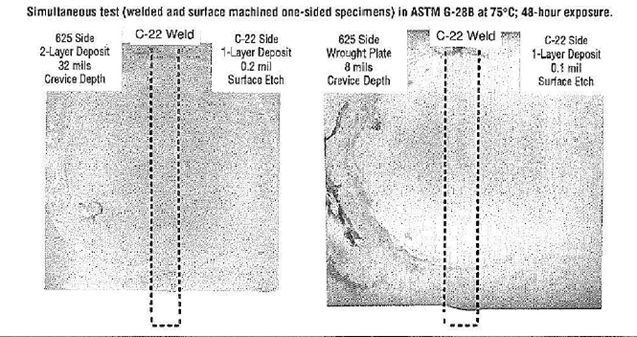
Iron dilution is often an issue raised by engineers interested in weld overlays for corrosion protection. Special chemistry weld wire is sometimes requested in the interest of achieving low iron dilution and the hope for better corrosion resistance of the weld overlay. It is inevitable that during weld surfacing there will be some dilution of the weld deposit from the base material. This dilution will modify the chemical composition of the weld deposit. Presumably, to achieve better corrosion properties of 625 weld overlays, a special low iron version of alloy 625 weld wire is used. This modified alloy is intended to permit welding practices which could increase iron uptake in the first pass, yet the overall iron level in the final pass would remain within the maximum allowable concentration of 5 percent Fe as specified in the American Welding Society (AWS) filler metal specifications.
The use of iron dilution as a measure of weld surfacing quality and hence weld overlay corrosion resistance can be misleading. A higher level of substrate dilution (usually permitted with low iron alloy625) lowers the molybdenum and chromium levels of the weld deposit while staying within the AWS specification on iron. It is not the iron content of the weld deposit, but rather t11e content of other alloying elements (molybdenum and chromium) that are important in achieving high levels of resistance to localized and general corrosion. The influence of dilution on the molybdenum content of two-pass weld surfacing deposits is s11own in graph below. This explains why even two layers of low iron 625 weld overlay (8.5 percent Mo and 1.2 percent Fe) offers less resistance to localized corrosion than a single layer weld overlay of C-22 alloy (13 percent Mo and 8.3 percent Fe).
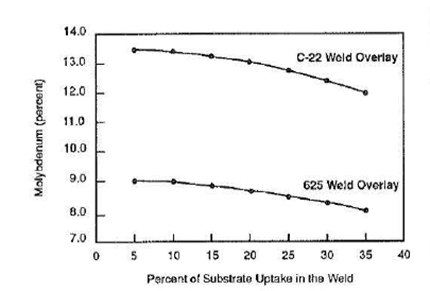
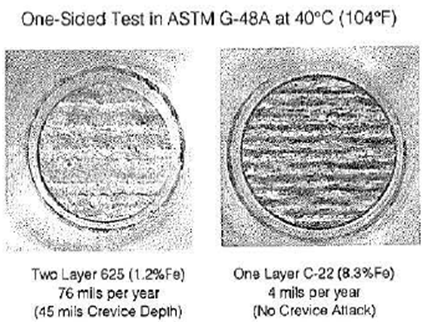
Corrosion of Weldments
Similar to stainless steels, the resistance of high nickel super alloy weldments to localized corrosion is inherently inferior to that of the same composition wrought products. However, the ranking in terms of resistance to localized corrosion remains unchanged. Of notice are the data showing C-22® weld metal being more resistant than wrought 625 base metal.
| Wrought Plates | 0.2% Yield Strength | Ultimate Tensile Strength | Elongation |
| - | ksi | ksi | % |
| 625 | 66 | 128 | 46 |
| C-22® | 54 | 114 | 62 |
| Cast Components | 0.2% Yield Strength | Ultimate Tensile Strength | Elongation |
| - | ksi | ksi | % |
| 625* | 41 | 87 | 55 |
| C-22®** | 41 | 81 | 65 |
| Weld Metal*** | 0.2% Yield Strength | Ultimate Tensile Strength | Elongation |
| - | ksi | ksi | % |
| 625 | 71 | 116 | 40 |
| C-22® | 76 | 113 | 47 |
*Welded with 625 filler wire **Welded with IN-1 12 Coated Electrode
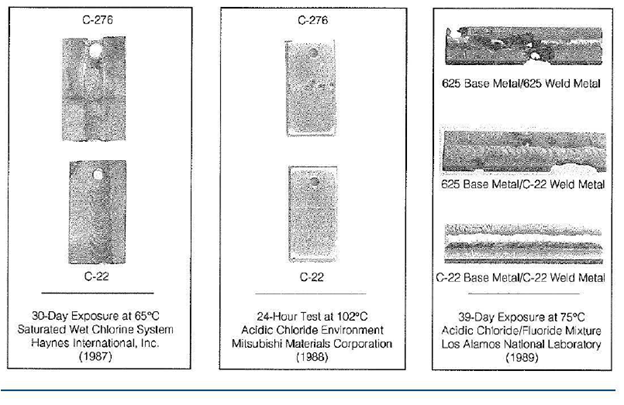
Mechanical Properties
In addition to the excellent resistance to localized corrosion, the high nickel alloys offer good mechanical properties, as wrought, as cast, and as welded components.
| As-Welded | Transverse Weld + Base Metal | |||||||
| Weldments | 0.2% Yield Strength | Ultimate Tensile Strength | Elongation | Impact Strength | ||||
| - | ksi | ksi | % | ft-lb | ||||
| GTAW | 76 | 65 | 113 | 114 | 47 | 47 | 148 | - |
| SMAW | 71 | 61 | 113 | 117 | 43 | 64 | 60 | - |
*625 cast = CW-6MC
**C-22 cast = CX2MW
***Gas Tungsten Arc all weld specimen
Good mechanical properties of HASTELLOY® C-22® weldments are maintained through different welding techniques.
| Wrought C-shape specimens ( app ≥ yield); coupled to C-Steel 25% NaCI+0.5% Acitic Acid, Saturated H,S; Room Temperature | ||
| - | 625 | C-22® |
| 50-60% Cold Work | No Cracking | No Cracking |
| 50-60% Cold Work + 200 h at 204°C | Cracking | No Cracking |
Even though high nickel alloys offer excellent resistance to stress corrosion cracking (SCC), distinction can be made in aggressive chloride environments containing hydrogen sulfide. The following sec test data relate to offshore platform services where high hydrogen sulfide (H2S) concentrations are encountered.
High Performance Alloys for Seawater Service Tech Brief 9
| Slow strain rate specimens, machined from weld overlay 25% NaCI+1 g/1 sulfur, 100 psi H2S, 250 psi CO2 | |||
| Overlay | Temperature | 625 | C-22® |
| - | °F | °C | - |
| One Layer | 375 | 191 | No Cracking |
| One Layer | 450 | 232 | Cracking |
| Two Layers | 450 | 232 | Cracking |
| HASTELLOY® C-22® alloy | |
| UNS | N06022 |
| Sheet Plate and Strip | ASME/ASTMSB 575/B 575 |
| Biller Rod/Bar | ASME/ASTMSB 574/B 574 |
| Coated Electrodes | AWSA 5.11 ERENiCrMo-10 |
| Bar Welding Rods | - |
| Seamless Pipe & Tube | - |
| Weld Pipe & Tube | - |
| Fittings | - |
| Forgings | - |
| DIN | - |
| TÜV | - |
| Others | - |

A 3-inch flanged gate valve of HASTELLOY® alloy C was installed in 1954 at the LaQue Corrosion Laboratory at Wrightsville Beach, NC on the downstream side of a condenser test set-up on a harbor-side pier. The valve was used in seawater service for over 22 years. (It was still good when it was removed because of a program termination.)
In 1955, HASTELLOY® alloy C was selected for use at Bahrain in the Middle East, as cathodes in electrodialysis process in desalination of seawater. This was the first large-scale commercial application of this new process for making brackish water drinkable.
In 1964, the first SNAP-21 atomic-powered weather station was put into service in the Gulf of Mexico using HASTELLOY® alloy C in double layers to encase the fuel to ensure against rupture and corrosion. Alloy C was selected as the most reliable container material for the fuel because of its resistance to corrosion in seawater. The container is designed for safe containment in seawater for the next 500 years!
Catalytic burners are used to purify the air in submarines. The purification process involves a heat exchanger/heater combination operating at 599°F (315°C). Large amounts of salt-laden air (with traces of fluorides) pass continually through the device. Because of the need for absolute reliability, the U.S. Navy requested that heat exchangers be made of HASTELLOY® alloy C-276. The 1971 heat exchanger design calls for thin (0.011 to 0.037 inch) sheets of alloy C-276 welded alternately either at the sides or at the top and bottom.
HASTELLOY® alloy C-276 was selected for the construction of plate t1eat exchangers for sulfuric acid production using seawater as the cooling medium. Each heat exchanger has a heat transfer surface of about 48 square yards (40m2) and cools 2.45 cubic feet per second (250M3/h) of 98.5 percent H2S04 from 158 to 131°F (70 to 55°C). An additional system for cooling acid fume mixtures (P2O5, H2SiF6) with seawater, is built of HASTELLOY® C-22® alloy due to the limited corrosion resistance of alloy C-276 to the process acid fume side.
Four heat exchangers made of HASTELLOY® alloy C-276 arepresently being used to cool sour gas with seawater in a French petroleum company’s offshore platform. Over 20 kilometers of alloy C-276 tubing is used in the exchangers. Two low-pressure, four-pass shell exchangers which handle the sour gas at 401°F (205°C) in the shell. The coolant is seawater passing through the tubes. Two additional high-pressure U-tube bundle exchangers cool the gas passing through the tubes, from 320°F (160°C) down to ambient. Alloy C-276 was selected for this application since other high nickel alloy tubing previously used suffered severe corrosion within a few months. Alloy C-276 has been in use since early 1983 and has given satisfactory service. In 1990, two new heat exchangers made of HASTELLOY® C-22® alloy have been added to offshore platform operations. Original alloy 825 tube sheets that corroded were also repaired with C-22® weld overlay (140 mil thick) and re-used successfully.
Oil tankers generate boiler exhaust gas containing SOx. These combustion gases (used as “Inert Gas Systems” or “lnertors” for padding oil on tankers) are often scrubbed and cooled by seawater. The system inlet duct and portions of the gas scrubber tower are lined with HASTELLOY® C-22® alloy which is constantly exposed to the hot seawater with temperature range of 572 to 338°F (300 to 170°C) and products of combustion containing sulfuric acid. C-22® alloy replaces alloy 825 and rubber linings, which performed unreliably in this application.
Toroidal swivel rings are utilized by a British Petroleum Company in single point mooring of ocean-going tankers in the Norwegian North Sea sector. This mooring system allows the tankers to connect up and take oil/gas on board and to inject seawater and chemicals into sub-sea wells. HASTELLOY® C-22® alloy was selected to replace alloy 625 for weld overlay of the critical seal areas. Along with its improved corrosion resistance, the C-22® alloy provided better weld with improved hardening characteristics.
The critical metallic v-seal areas in valve block bodies utilized in the North Sea Osprey sub-sea oil/gas field, are weld overlaid with HASTELLOY® C-22® alloy. The C-22® alloy replaces STELLITE® No. 6, which was cracking. The valves handle natural gas, hydrogen sulfide and seawater.
Application Specifications
| HASTELLOY® C-22® alloy | |
|---|---|
| UNS | N06022 |
| Sheet Plate and Strip | ASME/ASTM SB 575/B 575 |
| Biller Rod/Bar | ASME/ASTM SB 574/B 574 |
| Coated Electrodes | AWS A 5.11 ER ENiCrMo-10 |
| Bar Welding Rods | – |
| Seamless Pipe & Tube | – |
| Weld Pipe & Tube | – |
| Fittings | – |
| Forgings | – |
| DIN | – |
| TÜV | – |
| Others | – |

 en
en